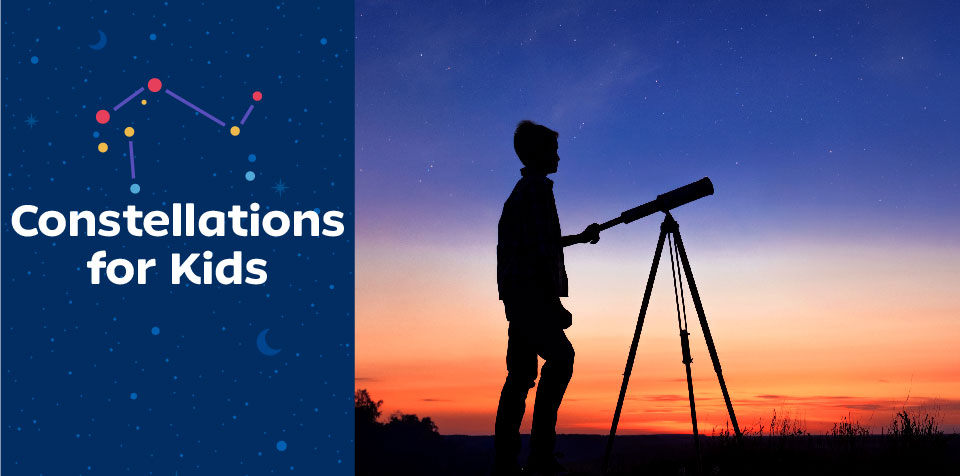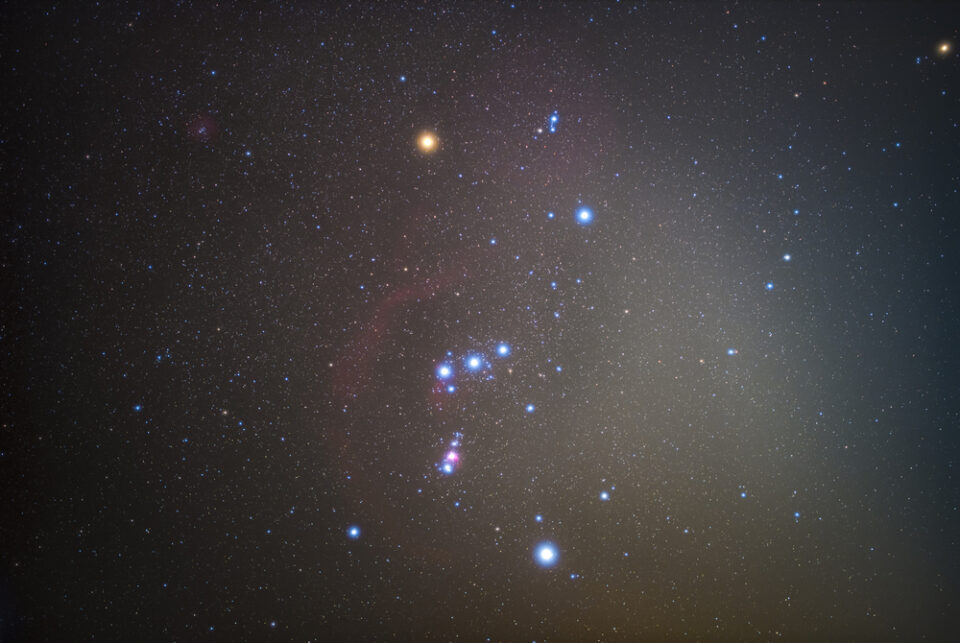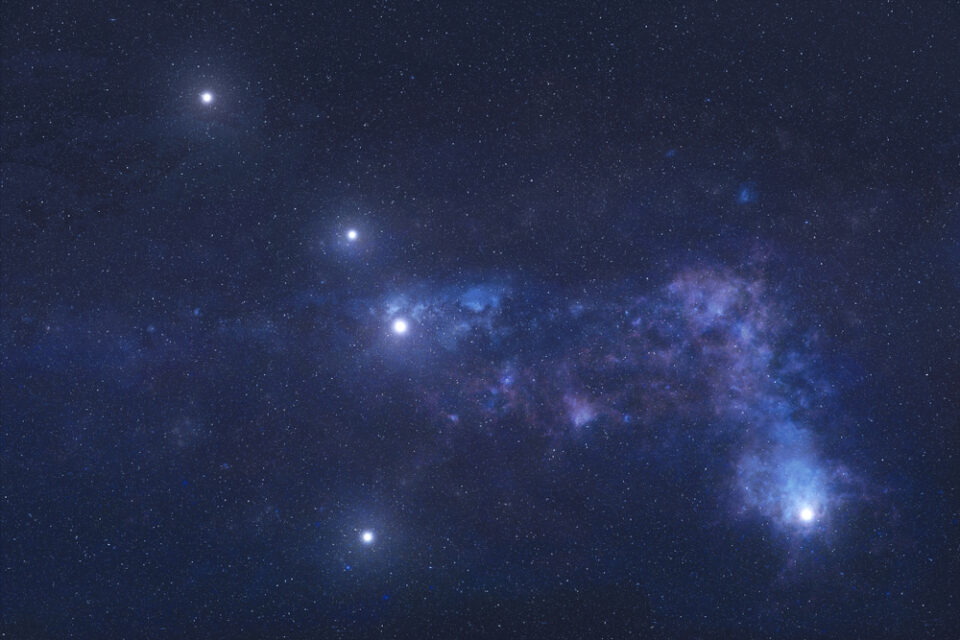
Let’s Explore the Constellations
Each day, sunset brings kids the opportunity to learn new things about their world. As nighttime arrives, the sky lights up with a fascinating natural marvel: stars.
We wish on stars. We sing about them. We wonder what they are (and what they’re made of). And for thousands of years, humans have found and named patterns in the stars—figures called constellations.
Admiring the twinkling shapes above is a wonderful way to spark your children’s imaginations and light up their curiosity. While you look up at the sky together, why not share some out-of-this-world facts about constellations for kids?
What Are Constellations?
A constellation is a group of stars that forms a pattern or image when viewed from Earth. Over the centuries, stargazers and astronomers have identified these shapes and named them after people, animals, and mythological creatures.
Think of constellations as dot-to-dot puzzles. The stars aren’t actually connected—in fact, they’re very far apart. But if you use your imagination to connect the dots, you’ll see the picture that earned the bundle of stars its name.
A Sky Full of Stars
Today, astronomers and space enthusiasts use constellations to identify specific stars in the night sky. But when ancient peoples named constellations, they served another purpose: preserving mythology.
Ancient Greeks believed the gods awarded their favorite heroes and creatures special places in the sky., In 150 CE, a scientist named Ptolemy (also known as Claudius Ptolemaeus) divided the night sky into 48 constellations, each named after a mythological animal or character. Over the years, astronomers identified more and more figures, labeling them on increasingly complex star charts.
By the nineteenth century, there were hundreds of constellations—but little consistency between charts. In 1919, a group of astronomers formed the International Astronomical Union to reach a consensus on the number of constellations. By 1922, they had created a star map of 88 official constellations—which is how many constellations there are today.
While there are many constellations in the sky, no one can see them all at once—your view depends on where you are on the planet, and where Earth is in its orbit around the Sun., For example, Ursa Major and Ursa Minor are only visible from the Northern Hemisphere (above the equator)., Meanwhile, Centaurus and Crux are only visible in the Southern Hemisphere (below the equator). The constellation Scorpius is only visible in the Northern Hemisphere in the summer and the Southern Hemisphere in the winter.

Well-Known Constellations
Learning the names of star constellations is a wonderful activity for any astronaut-to-be. Although there are 88 official constellations, a few “famous” star groups stand out among the rest. Here are some of the best-known figures:
Orion
Orion (pictured above) is one of the most recognizable constellations in the sky and is visible in both the Northern and Southern Hemispheres. The cluster is named after a hunter in Greek mythology.,
Ursa Major
Ursa Major (Latin for “greater bear”) is likely one of the first constellations ever identified by humans. This figure contains the group of stars known as “the Big Dipper,” which is technically an “asterism”—a well-known group of stars that isn’t an official constellation. The Big Dipper makes up the back leg and tail of the bear.
Ursa Major is only visible in the Northern Hemisphere, and for centuries, navigators used it as a compass because the constellation points toward Polaris, the North Star., If you can find Ursa Major, you can tell which way is north!
Crux
Crux is also known as the “Southern Cross.” It’s the smallest constellation and is only visible in the Southern Hemisphere. Fun fact: The constellation appears on the flags of the southern countries Australia, New Zealand, Brazil, Samoa, and Papua New Guinea.

What about the Zodiac?
Some constellations (like Crux and Ursa Major) are circumpolar. This means they never dip below the horizon, so people living in a particular hemisphere can almost always see them., Other constellations are only visible during certain times of the year, like those located along the ecliptic (the Earth’s path around the Sun)., Ancient astronomers named the star groups on the ecliptic the zodiac, and all of them can be seen (at least partially) with the naked eye. The zodiac includes:
Capricornus
Capricornus resembles a goat with a fish’s tail. People in the Southern Hemisphere can see it from June through October. In the Northern Hemisphere, it’s visible from August until November. Even when the timing is right, it can be tough to spot Capricornus because its stars are faint.
Aquarius
This constellation resembles a stream of water flowing from a jug. It’s easiest to see Aquarius in a Northern Hemisphere fall, while people in the Southern Hemisphere can spot Aquarius during their spring.
Pisces
Pisces is one of the largest constellations in the Zodiac (and the fourteenth-largest in the sky). Its name means “fishes” in Latin, and it represents the ancient Greek gods Aphrodite and Eros, who turned into fish to escape a monster. You can observe Pisces in both the Northern and Southern Hemispheres between September and January.
Aries
Aries (Latin for “the ram”) is about half the size of Pisces and much fainter. We can only see a few stars from this constellation with the naked eye (and these stars are most visible on December evenings above the equator.), The constellation is visible from autumn through winter in the Northern Hemisphere and in spring and midsummer in the Southern Hemisphere. Despite its dim appearance, Aries is the starting point for a unique space phenomenon: a daytime meteor shower between May and July called the Arietids., Daytime meteor showers are only above the horizon during the day, so they can’t be seen at night.
Taurus
Taurus is the oldest named constellation— its image, a bull, appears in cave paintings from seventeen thousand years ago! Taurus is visible in the Northern Hemisphere between November and March and the Southern Hemisphere the rest of the spring through fall.,
Gemini
No matter which hemisphere you’re in, December through March is the best time to see Gemini, a constellation named after twins Castor and Polydeuces in Greek mythology. There are ten named stars in this group, but most people only see the two brightest (called Castor and Pollux) when they’re stargazing., Gemini is the starting point for a meteor shower called the Geminids, which occurs each year in early December.
Cancer
Cancer (“the crab” in Latin) is the dimmest zodiac constellation. It’s so faint that it’s almost impossible to see with the naked eye—and even through binoculars. Cancer is visible in most places around the world from September to June, but it’s easiest to find during the early spring.
Leo
While Cancer is dim, its neighbor Leo is one of the easiest zodiac constellations to find. This star group means “lion” in Latin and represents the Nemean Lion defeated by Heracles (also known as Hercules) in Greek mythology. Leo shines brightest in both the Northern and Southern Hemispheres during March, April, and May.
Virgo
Virgo (or “the maiden”) is the largest constellation in the zodiac and the second-largest overall, although many of its stars are too faint to see with the naked eye. The best time of year to see Virgo is in May—look for Spica, the brightest star in the constellation and the fifteenth-brightest in the sky.
Libra
Libra is the only zodiac constellation named after an inanimate object. Its name means “balance” in Latin and represents a pair of weighing scales. Libra is easiest to spot in most of the world between late spring and early summer, but it is very faint. This is likely because many of Libra’s stars are very old, including Methuselah, the oldest-known star in the universe.
Scorpius
Scorpius, like Leo, is easier to find than its neighbors. The constellation is brighter than Libra and has a more prominent shape (said to be a scorpion with a curled tail). If you’re stargazing in July or August, when Scorpius is most visible, look toward the center of the Milky Way (our galaxy, which appears as a cloudy stripe of stars across the sky). If you see a red star (called Antares), you’ve found the scorpion’s heart!
Sagittarius
Sagitarrius (“the archer”) resembles a half-horse, half-person creature from Greek mythology called a centaur holding a bow and arrow. It’s a large constellation—only a little smaller than Pisces. Sagittarius is most visible in August, and thanks to its many bright stars, it’s fairly easy to see with the naked eye.
Ophiuchus
Ophiuchus is a unique zodiac constellation. It’s often called “the forgotten constellation” because it isn’t used in astrology, unlike the star groups above. Ophiuchus (or “the serpent bearer”) is the easiest to spot in most places on Earth between May and October. This constellation resembles a man holding a snake, which according to ancient Greek myth is Asclepius, son of the god Apollo.

